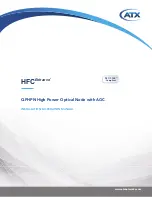
2-2
HFC Enhance
®
– QFHPN High Power Optical Node with AGC – Installation & Operation Manual
CHAPTER 2: INSTALLATION AND OPERATION
2.1
Installation
The ATX Networks QFHPN compact node is designed to operate in a utility room or closet. It must be placed in a location
where it will not be directly exposed to liquid or to extreme temperatures.
Please refer to Figure 1 or Figure 2 above
(depending on model being installed) for installation and operation.
2.2 Mounting
The compact node is designed to be mounted directly on a wall or other indoor surface. It should be placed so an operator
can view the status display for installation or troubleshooting. Attach the compact node to a wall board with the connectors
facing downward. Use appropriate mounting hardware (not included) for the surface you are mounting it on. The slots on the
compact node will accommodate screw type fasteners from sizes #8 to #12.
2.3 Grounding
The compact node should be grounded to electrical/utility ground using at least #10 solid ground wire. This will minimize the
risk of electrical shock and minimize the effect of noise on the coax cable inside the building. Follow all electrical codes and
standards that apply when installing this equipment.
2.4 Connecting COAX
Connect the building video coax wire to the output of the CATV compact node. For best results the building should use RG6
coax cable or better with as short of runs as possible. The compact node is designed to output 40dBmV of RF power (44
dBmV x2 on QFHPN-D44), and includes the ability to compensate for long distance coax runs if long runs cannot be avoided.
Be sure that all electrical couplers are of the 2-way type, or poor performance will result with cable modems and some set-top
boxes. When attaching the coax cable to the CATV compact node, use appropriate tools – do not over tighten or you may
damage the node. A loose or damaged coax connection may also result in poor signal stability as temperature changes over
time.
2.5 Connecting Optical Fibers
CAUTION: NEVER look into the ends of a fi ber optic cable that is connected to the network!!
Communications systems use lasers that emit invisible infrared light, which can do permanent
damage to your eyes.
Other general recommendations:
•
Use only Single Mode Fiber (SMF) optic cable (9/125µM). Multi-Mode Fiber (MMF) is incompatible with the equipment
and will result in unacceptable performance and possible damage to the equipment.
•
All fi ber splices should be fusion-type splices. Avoid mechanical or compression type connections.
•
Insure that you follow local practices when working with fi ber optic cable as tight bends or excessive pulling on the
fi ber jumpers may damage the cable.
•
For optimum performance, fi ber runs should be made directly from the transmitter to the receiver. Minimize the use
of adapters, patch panels and additional points of failure and signal loss.
•
In order to ensure return loss is maximized, use only SC/APC connectors. Clean and inspect connectors and fi ber
end-faces prior to installation, and every plug in/out cycle.
•
Use only industry approved methods, materials, and solutions for cleaning.
•
Do not turn on the transmitter alone or without a protector cover at the unit connector end, otherwise the laser can do
harm, especially to eyes. This is especially critical because the laser is invisible.
•
Always turn off the laser prior to making connections to the transmitter. Failure to do so may cause irreparable
damage to the laser and transmitter.
Attaching the fi bers to the CATV compact node:
•
Before connecting the optical fi ber to the CATV compact node, inspect and clean the optical connector before
connecting the optical network jumper.
•
Insert the forward path fi ber into the correct connector and confi rm that the cable “snaps” into place.
•
Clean and inspect the upstream return path connector on the compact node and connect the return path fi ber jumper.
Confi rm that the return path connector “snaps” into place (QFHPN-2W only).














